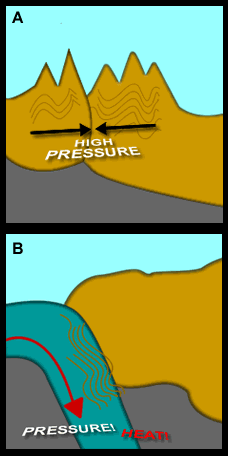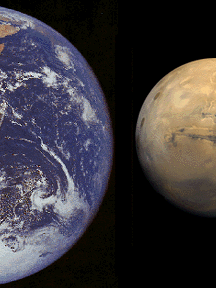This is an image of the Martian dunefields.
Click on image for full size
NASA
What causes a Planet's surface to change?
Over the course of time there are many things which can cause the surface of a planet to change its appearance.
- winds can slowly wear erode a planet's surface.
- The surface of Mars is affected by wind.
- Monument Valley on Earth is an example
- weather & water cause more dramatic erosion.
- volcanism, which pours out a new surface
- The maria on the Moon are examples.
- plate tectonics, or continental drift
- slow forces of uplift & deformation similar to those which cause mountains to form.
- relaxation of craters, mountains and volcanoes.
In their earliest histories, every planet & moon was bombarded with the remains of the material which formed them. If a planet's surface does not show many craters, it means that the surface is new, and the planet has been resurfaced, perhaps by one of the processes above. If the planet's surface still shows the many craters left over from it's formation, then that same surface was present during the ancient bombardment, and has not been changed by any activity.
You might also be interested in:

How did life evolve on Earth? The answer to this question can help us understand our past and prepare for our future. Although evolution provides credible and reliable answers, polls show that many people turn away from science, seeking other explanations with which they are more comfortable.
...more
Rocks are broken apart by two types of weathering. By chemical weathering, the minerals in rocks are dissolved into rainwater or changed from one type of mineral into another. Climate is an important factor
...more
Volcanism is part of the process of bringing material up from the deep interior of a planet and spilling it forth on the surface. Eruptions also deliver fresh gases to the surface from the melted material
...more
This picture of the lunar maria shows the difference betwen the highlands, which are heavily cratered, and the dark maria which are relatively smooth with few craters. The absence of craters indicates
...more
A large amount of metamorphism over a broad geographic area is called regional metamorphism. Movements of the Earth's tectonic plates are the primary cause of regional metamorphism. As continental plates
...more
In addition to being hot, the surface of the Earth was being cratered. Even though the solar system was finished forming, there were still probably a lot of smaller planetesimals and debris around, too.
...more
For many planets, such as Mercury, shown here, pictures show that there are lots of craters. The craters were formed early in the history of the planet. Because there are so many craters, scientists can
...more
Any successful theory must account for everything we know about the Moon now, as well as make predictions about future observations. There are three theories about how the moon came to be in place: that
...more














